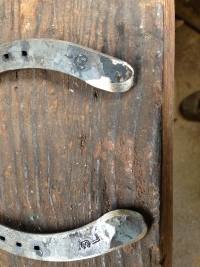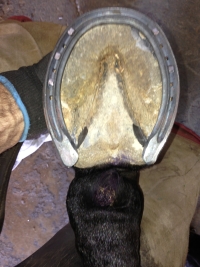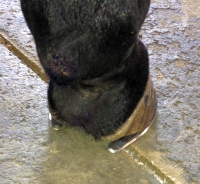I recently shod a trotting filly late in the Red Mile meet. The racing schedule can start to take a toll on horses in late September as the season matures and she had begun to run down on the right hind.
Running down means the back of the ankle touches the racetrack during the stride. This normally happens during the extremes of exertion as with racing or a fast training mile.
Having started to run down after she already had logged several starts without doing so and only touching the ground on one side, I believed it to be the result of an underlying problem. Of course, most—OK, let’s just say all--gait and interference issues that develop after the season is underway are the result of an underlying problem. When racehorses compensate for a nagging pain, other problems occur. Beginning to run down on a single hind leg is a classic manifestation of this.
I will add that the filly was not overdue to be shod, and did not have a four-inch toe length behind (four inches is just a number, but would be considered long for a hind hoof; long hind toes can lead to running down).
The quick-fix idea here is simply add a little length to the shoe. When trimming her hind hooves, I first made sure that the hoof wall was not excessively wider at the toe than the rest of the hoof.
I’ve said before that a distorted (thickened) hoof wall in the toe is stressful to the hoof capsule and lower joints. It creates a lever against break-over and keeps a hoof in loading phase of the stride longer than normal; this is the circumstance that creates stress issues among which is running down. I made certain that distortion was in check (in her case it wasn’t very bad at all), and finished trimming her hoof. I then measured her hoof width and found it to be 4-5/8 inches wide. A hoof that wide would normally require a size 2.5 shoe. In this case, I used a size 3.
I also forged the heels of the shoe by tapering the last half-inch or so from the hoof side of the shoe (Fig. 1). This is done to lengthen and broaden the ground side of those heels adding more support in the back of the hoof over which the running down is occurring.
Figure 2 shows the effect of that forging as it looks on the hoof. If you look beyond those heels, one can see the sore on the back of her ankle which is the result of running down.

(Photos by the author) Fig. 1: The author forged the heels of the shoe by tapering the last half-inch or so from the hoof side of the shoe.

Fig. 2 shows the effect of that forging as it looks on the hoof.
Run down sores are one indicator I always look for. This one is fairly mild. By using a half-size larger shoe and forging out the heels, I have created much more support in the back of her hind hoof. In Figure 3 it shows the shoe is broader and longer than the distal border of the hoof wall itself (ground side) and actually extends out to the hairline of her heel bulbs. This will normally add enough support to a horse that runs down just a little.

Fig. 3 shows the shoe is broader and longer than the distal border of the hoof wall itself (ground side) and actually extends out to the hairline of her heel bulbs.
I feel compelled to say that it is considered a good, supportive shoe fit for any hind foot. Also, I restate that we might just be preventing symptoms of other problems and not the actual reason she runs down. As a quick fix, this takes almost no extra time to do, but might alleviate a nagging pain.
Veteran Standardbred farrier Steve Stanley of Lexington, Ky., authors a monthly column for Hoof Beats, the official harness racing publication of the U.S. Trotting Association. The American Farriers Journal Editorial Advisory Board member offers plenty of practical advice that will be of special interest regardless of the type of horses that you work with. Click here to read more from Steve Stanley's Hoof Beats series.
Learn More
Back Up the Horse’s Entire Foot, Not Just the Toe
"Backing up the toe" might make the foot look aesthetically pleasing, but 6 weeks later all the work that was done previously needs to be done again. Focusing on just the toe leaves out the rest of the foot. Instead of thinking of backing up the toe, the focus needs to be on “backing up the whole foot.”








Post a comment
Report Abusive Comment